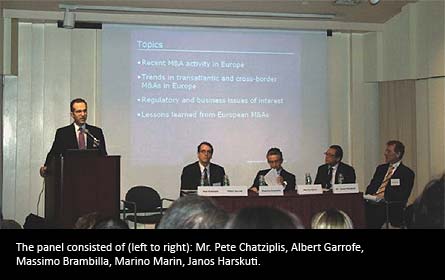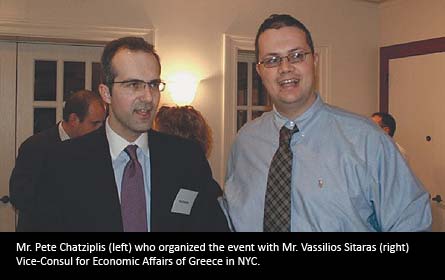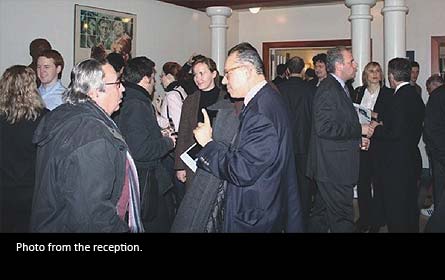Special conference at NYU on Transatlantic Mergers and Acquisitions
A special conference to discuss the Growth in Transatlantic Mergers and Acquisitions was organized recently by Pete Chatziplis and by Vassilios Sitaras, the Vice-Consul for Economic Affairs of Greece in NYC and hosted at the Italian Cultural Institute of New York University.
It was sponsored by the delegation of the European Commission in the US and organized in cooperation with the alumni association of the Bocconi Business School, the Spanish American Chamber of Commerce and the Portuguese American Chamber of Commerce.

The conference panel of experts included investment bankers Marino Marin of Gruppo, Levey & Co. and Massimo Brambilla of Fredericks Michael & Co, Albert Garrofe of the Spanish international law firm Cuatrecasas and Dr. Janos Harskuti, the Consul for Financial and Commercial Affairs of Hungary in New York. Pete Chatziplis of Deloitte Financial Advisory Services moderated the discussion.
Mergers & acquisitions in Europe have been growing at such a pace that in 2006, a record year for global M&A activity, reached the US level at around $1.4 trillion accounting for 40% of total value globally. Even in 2007, amid the turmoil in the credit markets, European M&A activity has remained strong. Partly helped by the appreciation of the Euro, European companies have been increasingly involved in acquisitions in the US. At the same time US investors continue to be active in Europe as corporations are expanding in new markets, especially the growing ones of Central and Eastern Europe, while private equity funds are finding attractive ways to invest their capital there.

Although the European Union may offer a lot of opportunities to US investors, one should be aware that it also may pose significant challenges when it comes to pursuing an acquisition. There’re 27 countries and 27 government and legal systems in the European Union today, not to mention regional governments and municipalities, languages and cultures that play a critical role for the success or failure of acquisitions even if these are initiated from within the EU. There’re three main legal systems: the Anglo-Saxon the Continental and the Eastern European. Even though there’s an effort to harmonize the systems, differences do exist. Likewise even though the EU wants to stimulate competition there’s protectionism at national level especially in regulated and strategic sectors such as energy and utilities. France, Italy and Germany are considered as the more protectionist countries. For all these reasons local input is absolutely necessary when contemplating an acquisition. Strategy and tactics should be adjusted on a case by case basis.
When it comes to destination of US investment, Central/Eastern Europe tops preferences, while UK which is the less protectionist European market, follows. Skilled labour force, competitive wages, growing GDP, are some of the factors that have attracted investment in Central/Eastern Europe and at the same time increased the valuations there to high levels. Investors from Germany, UK and Austria as well as Greece in the Balkans are also active in Central/Eastern Europe. It is believed that investment in Eastern Europe has contributed to the growth of the Greek economy over the last years. Oil-rich Russia is also becoming interested to the region.
As regards sectors of interest for US buyers these are mainly financial services, technology, pharmaceuticals, media and the consumer sector. Transportation, construction and utilities are preferred the less. Private equity, mainly the larger funds, are also present in transactions but to a somehow lesser extent than in the US. Although average deal sizes are smaller in Europe that in the US it’s quite difficult for small and medium US funds and private investors to invest there as they lack local expertise and might find it difficulty to pull together management teams. Middle Eastern funds are also increasingly active in Europe.
On the other side European companies that are investing in the US are mainly targeting the technology sector and secondly pharmaceuticals and financial services. As the panel argued, the appreciation of Euro may increase transatlantic activity in the middle market but it is not expected to affect the larger companies on both sides of the Atlantic as these are hedged against currency movements and they plan their moves with a long term view in mind.
